Batteries | Consumption | Battery Recharging | Solar Charging | How Long Without Sun? | Alternate Charging Options | Solar Regulators | The Bottom Line
<<< Getting started with a Portable Fridge & 12V Power
See also:
| The Basics…. | |||||||||
|
Looking for a quick (and affordable) fridge & portable 12V power setup? Here is what you need…. |
|||||||||
You only need the solar stuff if you are planning on being off-grid for more than a few days. A Lithium battery in a wired battery box will run a small chest fridge for several days without the need to recharge. However, you will need a 230V AC charger to charge your battery before you leave, and to recharge the battery when you are back home. ($90 – $180) |
|||||||||
|
|
|||||||||
|
|||||||||
|
|
|||||||||
| All the Bits and Pieces | |||||||||
|
Fridge
|
Choose a fridge/freezer with a capacity to suit your needs. (What size? – Best to visit a retail outlet to assess fridge capacity in the real world.) Be aware that single zone fridge/freezers can be used as a fridge OR freezer while dual zone fridge/freezers provide fridge AND freezer compartments.
If you are staying in a campground with mains power available, this might be all you need. But if you are venturing to more out-of-the-way places, you will also need a portable power supply….. |
||||||||
|
|
|||||||||
|
12V Power |
Choose a portable power option that meets your power needs and budget… | ||||||||
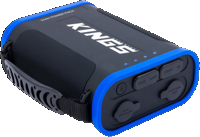 |
Option 1: Portable Lithium Power Pack
|
||||||||
|
|
Option 2: Powered Battery Box (+ Battery) You can then plug your portable fridge straight into a battery box socket, as well as powering other devices from built-in USB and Anderson outlets. If you are shopping for a battery for the battery box, give heavy AGM batteries a miss and go with a longer lasting and much lighter Lithium battery. (IMHO!)
|
||||||||
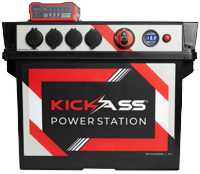 |
Option 3: Battery Box Power Station (+ Battery)
|
||||||||
 |
Option 4: Portable Lithium Power Station
|
||||||||
|
|
|||||||||
|
Battery Charging
|
Extend your fridge’s off-grid run time by recharging your battery – with a solar panel while camping or with the car alternator while driving. Make sure your battery is fully charged before your next trip, with a 230V AC-DC charger….
|
||||||||
|
|
|||||||||
| An Inverter? Not required to run your portable fridge, but may be a useful accessory to add a 230V outlet to your 12V power supply… | |||||||||
|
Inverter
|
Adding 230V AC power: An inverter is very much a ‘maybe’ add-on option to connect to your Battery Box, but only for very low power appliances – charging a laptop, or charging batteries for a drone or a camera, or maybe an e-Bike, etc. There are lots of limitations to consider before you get too carried away with thinking about running higher power appliances like a coffee machine or a sandwich press – especially with only 1 x 120 Ah battery, and (most importantly) the limitations of the cabling in a wired battery box. There aren’t too many ‘low power’ inverters available these days – 1000W is now considered to be ‘low power’. An inverter doesn’t use too much power itself, but is capable of supplying its rated power output to connected appliances – but only if it can draw that much electrical current from its 12V input source – your Battery Box. Most wired Battery Boxes are protected by internal 30A fuses, so the most power you are likely to be able to supply from an inverter connected to a Battery Box is around 300W. More than this and you will blow the internal fuses in a Battery Box. Check the label on your AC appliances for a power rating before getting too ambitious. Some ‘low power’ inverters include…
Inverter reality If you really need more than 300W of 230V AC power, you should be looking for options beyond a basic Battery Box.
|
||||||||
|
|
|||||||||
| The easy (but more expensive) all-in-one option… | |||||||||
|
Portable
|
The really easy (and safe) alternative option to all of the above is a self-contained portable Lithium power station – with 12V cig socket/s and Anderson socket/s for connecting your fridge & lights, USB-A and USB-C outlets and wireless charging panels for phones, etc, along with built-in charging regulators for 230V AC, 12V DC and Solar inputs – plus a built-in inverter to supply 230V AC…
The power stations listed here include the battery capacity in Amp Hours (Ah) to make it easier to compare models, and to compare the power station’s battery capacity with other 12V battery power options. (A basic Battery Box option is 100Ah or 120Ah). Manufacturers of power stations often name the model, and advertise the model specifications, based on the output of the built-in inverter in Watts (W), or list the battery capacity in Watt Hours (Wh), because these are larger numbers than the Amp hour capacity and look better in the advertising. (Divide Wh by 12.8 to convert to Ah @ 12V.) |
||||||||
|
|
|||||||||
| Note: Most of the Adventure Kings gear mentioned here is regularly ‘on special’ – keep an eye on their website or join their mailing list for the latest updates. Ditto for Jaycar, KickAss & iTechWorld, though not as frequent as Kings. | |||||||||
|
|
|||||||||
|
Read on for more detailed info on portable fridges and 12V power equipment, and setup options…. |
|||||||||
| Overview – Fridge & 12V Power to Go |
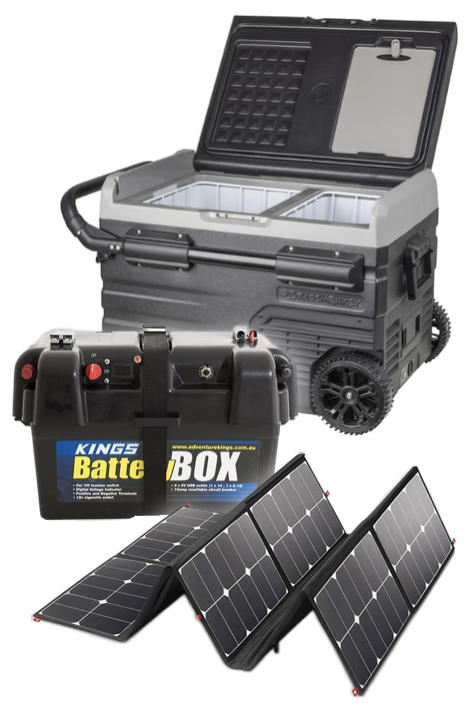 Although CompactRV is focused primarily on Campervans and Motorhomes with built-in appliances and power, we do have plenty of discussions with enthusiastic campers looking to set up the basics at minimal cost – weekends away in the back of a van or in a tent, but still able to run a fridge and lights, and keep phones and other devices charged.
Although CompactRV is focused primarily on Campervans and Motorhomes with built-in appliances and power, we do have plenty of discussions with enthusiastic campers looking to set up the basics at minimal cost – weekends away in the back of a van or in a tent, but still able to run a fridge and lights, and keep phones and other devices charged.
All very doable!
In this scenario we can create a portable power supply, using a 12V deep-cycle battery fitted in a powered Battery Box – then just plug in a portable fridge, and even hook up a solar panel to recharge the battery for longer off-grid excursions. A low-power inverter is also an option to provide a 230V outlet for charging drone and camera batteries, eBike batteries, or a laptop.
A 120 Ah (Amp hour) deep-cycle battery is able to deliver the low current output required to power a fridge for a couple of days, without any recharging (1 or 2 amps average per hour, consuming 1-2 Ah battery capacity per hour). A battery of this size fits in a standard Battery Box, and is ideal for storing electrical energy for a portable 12V power supply. A Lithium battery (LiFePo4) is recommended – you get a much longer fridge runtime, and because Lithium batteries are less than half the weight of old lead-acid AGM batteries your power supply becomes truly ‘portable’. (120Ah AGM batteries weigh over 30kg)
Fitting the battery in a powered Battery Box keeps it neat and tidy, while providing plug ‘n’ play connection sockets for 12V cig plugs, USB outlets, Anderson connectors and a voltmeter – a portable 12V mini power station in the back of your car or van.
Connect a solar blanket (with a controller) and/or a 230V charger and you have a rechargeable portable power system.
Just connect a fridge (and other electronic devices) to make your campsite a mini home away from home!
| Options & Scenarios – Get the gear to make it happen |
Below is a brief summary of some of the portable 12V power and fridge options that are readily available to build a portable camping station. Regardless of which option you choose, it all boils down to three components – a Fridge, a Battery to store energy to power the Fridge, and a means of recharging the battery….

When it comes to fridges, batteries, solar panels and battery chargers, there is a wide range of equipment available. Prices listed below are ‘regular’ prices (2024/25), but much of this stuff is often available with discount pricing at EOFY, Easter, Black Friday sales, etc. (Kings equipment is ‘on special’ every week or month – and their ‘bundles’ are often cheaper than the single item.)
For short-term casual camping trips, a couple of times a year, you may not need anything too up-market. It all depends where you are staying, how long you will be staying there, and how much money you want to spend.
To help make the examples below more comparable, we have used the same model fridge – a single zone 42 litre Brass Monkey fridge – in each setup (except for the Lux example)….
Note: Our updated list below now only includes Lithium battery options. You could save a few dollars by substituting an AGM battery for a Lithium battery.
| On-Grid – Campground – unpowered site (No-cost power option) |
$0 | |
 |
Fridge: Use the shared fridge in the camp kitchen | $0 |
| Power & iDevice recharging: Use outlets in the camp kitchen | $0 | |
| On-Grid – Campground with 230V on-site power (Easy power) |
$350 | |
 |
Fridge: Brass Monkey 42L (single zone) | $300 |
| 230V Power: 15A Caravan extension lead | $50 | |
| 230V Adaptor: Included with fridge | $0 | |
| 12V Car Adaptor: Included with fridge | $0 | |
| Device Recharging: USB outlet on fridge, on-site power outlet | $0 | |
| Off-Grid – Overnighter (Fridge + built-in battery or Power Pack) |
$580 | |
 |
Fridge: Brass Monkey 42L (single zone) | $300 |
| 12V Power: 15.6 Ah built-in fridge battery | $280 | |
| (Note: Removable battery lasts around 8-10 hours before a recharge is required from the vehicle cig socket or a solar panel.) | ||
| 230V AC Charger: Included in BM fridge | ||
| 12V DC Charger: Included in BM fridge | ||
| Solar Panel: (Optional) Kings 240W Blanket ($230) | ||
| Solar Charger: Included in BM fridge. An Anderson adaptor connecting cable required ($30) | ||
|
Lights and device recharging – Independent battery banks or car charger. There is a USB slot available on the fridge.
|
||
| Off-Grid – Long Weekender (Lithium battery in a Battery Box) |
$880 | |
 |
Fridge: Brass Monkey 42L (single zone) | $300 |
| 12V Power: Kings 120Ah Lithium Battery & Box | $400 | |
| Battery Box: Included in battery box ‘combo’. | ||
| A fully charged 120Ah Lithium battery will have enough stored energy for 4-5 days with sensible fridge use. (Our 42L fridge uses around 1Ah per hour, depending on conditions.) | ||
|
230V AC Charger: KickAss 230V 22A charger (for charging the battery at home before you leave.) 12V DC Charger: Nil |
$180 | |
|
|
||
 |
Alternative Long Weekender: Power Station option | $1250 |
| Fridge: Brass Monkey 42L (single zone) | $300 | |
| 12V Power: KickCharge 1200 Power station (80Ah) | $950 | |
| Battery recharging: 12V DC, 230V AC, Solar charging regulators included in power station | ||
| Inverter (230V): Included in power station | ||
| Off-Grid – Wanderer (Lithium battery + Solar charging) |
$1160 | |
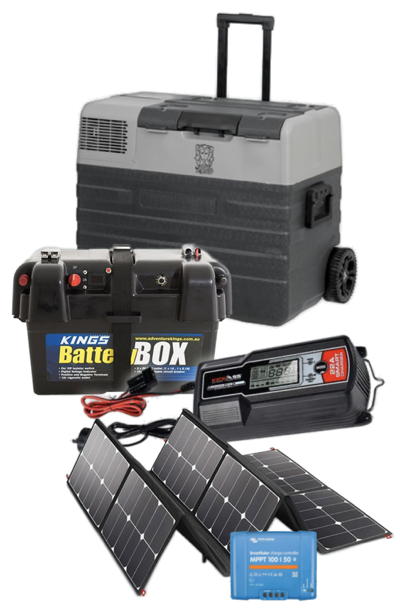 |
Fridge: Brass Monkey 42L (single zone) | $300 |
| 12V Power: Kings 120Ah Lithium Battery + Box | $400 | |
| Battery Box: Included in battery box ‘combo’. | ||
| Solar Panel: Kings 240W blanket | $230 | |
| Solar Charger: Kings MPPT Regulator | $50 | |
| 230V AC Charger: KickAss 230V 22A charger (for charging the battery at home before you leave.) | $180 | |
| 12V DC Charger: Nil | ||
|
|
||
 |
Alternative Wanderer: Power Station option |
$1480 |
| Fridge: Brass Monkey 42L (single zone) | $300 | |
| 12V Power: KickCharge 1200 Power station (80Ah) | $950 | |
| Solar Panel: Kings 240W Blanket | $230 | |
| Battery recharging: 12V DC, 230V AC, Solar charging regulators included in power station | ||
| Inverter (230V): Included in power station | ||
| Off-Grid – Power Plus (Lithium battery + Solar + DC-DC Charger) |
$1800 | |
 |
Fridge: Brass Monkey 42L (single zone) | $300 |
| 12V Power: iTechWorld 120Ah Lithium battery | $600 | |
| Battery Box: iTechWorld GoFurther Battery Box | $300 | |
| Solar Panel: iTechWorld 200W blanket | $600 | |
| Solar Charger: Included with blanket | ||
| 12V DC Charger: Included in battery box | ||
| Optional: KickAss 230V AC 22A charger – $180 | ||
|
|
||
 |
Alternative Power Plus: Power Station option | $2500 |
| Fridge: Brass Monkey 42L (single zone) | $300 | |
| 12V Power: iTechWorld PS1800 Power Station (120 Ah) | $1500 | |
| Solar Panel: Kickass 300W Super Thin panel | $700 | |
| Battery recharging: 12V DC, 230V AC, Solar charging regulators included in power station | ||
| Inverter (230V): Included in power station | ||
| Off-Grid – Lux Family (Big fridge, Big power + AC + DC + Solar) |
$3200 | |
 |
Fridge: Brass Monkey 95L (dual zone) | $500 |
| 12V Power: iTechWorld PS2000 Power station (160Ah) | $2100 | |
| Solar Panel: iTechWorld 200W blanket | $600 | |
| Battery recharging: 12V DC, 230V AC, Solar charging regulators included in power station | ||
| Inverter (230V): Included in power station | ||
More suggestions: : QuickStart Guide to 12V Power Options >>>
| Digging down – More detailed equipment info…. |
1. Fridge/Freezers
 Portable 12V fridge/freezers have traditionally been relatively expensive items. Engel and Waeco have been the market leaders for many years, with fridges in the $1500+ bracket. These fridges are extremely reliable, have a reliable compressor with a proven track record, and usually offer a 5 year warranty.
Portable 12V fridge/freezers have traditionally been relatively expensive items. Engel and Waeco have been the market leaders for many years, with fridges in the $1500+ bracket. These fridges are extremely reliable, have a reliable compressor with a proven track record, and usually offer a 5 year warranty.
Over the past few years more affordable brands have appeared in camping supply stores. There are plenty of fridges available these days in the sub-$1000 and sub-$500 categories.
Adventure Kings, Brass Monkey and Anaconda (Dune) offer reliable fridge/freezers in the ‘affordable’ price bracket….
Kings Stayzcool fridges are a higher-spec model than their Escape models, with a Smartele compressor and a powder-coated steel body, and a 5 year warranty.
Many Brass Monkey fridges include a battery compartment (battery optional) with a built-in solar regulator, AC-DC charger and DC-DC charger. They also have a Bluetooth app for controlling the fridge from your phone and a 3 year warranty. (Brass Monkey fridges are available at Jaycar and other retail outlets.)
Kings and Brass Monkey fridges include a 12V DC car adaptor, and most (but not all) include a 230V AC adaptor.
What to look for when shopping for a fridge?
Zones – The main sub-category to consider when shopping for a portable fridge/freezer is whether it is single zone (fridge OR freezer) or dual zone (fridge AND freezer). For most casual camping applications, a single zone fridge will do the job. If you are camping with the whole family and want to be able to store frozen meat, ice-cream etc for the tribe, then a dual zone fridge is the one to go for.
Capacity – Next consideration is fridge volume. A 30-60 litre model will likely be sufficient for one or two people for short trips. A fridge with 80-100 litres capacity might be required for a family, especially if splitting the capacity between fridge and freezer in a dual zone model. Visit your local camping supply store and have a look at their display models to get an idea of what size will best suit you.
Size – Related to the capacity of course, the physical size of a fridge is an important consideration, especially if you have a vehicle with limited storage space. A large dual zone fridge can fill the boot of a small car. Fridge specs – with dimensions – are published on retailer’s web sites. (A 90L dual zone fridge/freezer is around 1000mm wide and 600mm deep!) Measure up your boot space before making any decisions – and remember that you need ventilation space around the fridge.
Power – Most (but not all) portable fridges include a 230V power adaptor and a 12V car adaptor. We have used Brass Monkey examples in the table above because most of their fridges include a 230V AC adaptor and a 12V car adaptor, and many of their fridges also include a built-in solar controller to recharge an (optional) removable 15.6Ah Lithium battery – as well as built-in AC and DC charging facilities for the battery. Very handy as a backup power supply for a few hours, or even overnight. (A 230V adaptor is optional on some of the smaller Brass Monkey fridges.)
Power consumption – We have tested a 42L Brass Monkey fridge, and measured the amps it was consuming. When the compressor is running, the fridge is drawing just under 3 amps. But the compressor only runs for around 10 minutes each hour (2 x 5 mins) which works out at around 1 Ah of battery capacity per hour (or less). This was measured with the fridge set at 4°C, at an ambient temperature of 25ºC – the fridge would likely draw a little more current in warmer conditions. At this consumption rate you will get 10 hours run time from the (optional) 15.6Ah built-in battery.
2. Power
2a – ON Grid – 230V
 Staying on a powered site? Then no portable 12V power supply required!
Staying on a powered site? Then no portable 12V power supply required!
All the portable fridges are supplied with a 12V adaptor (for running from you car while in transit), and most (but not all) are supplied with a 230V AC adaptor. If not included they are available as an optional extra.
If you are staying in a campground with 230V power available, you can plug your fridge straight into your on-site power. Drive all day with the fridge running on 12V via the car adaptor, then arrive at your powered site and plug the fridge into your on-site 230V outlet. No other options required.
Make sure you pack a 15 amp caravan extension lead (at least 20m long), and a power board, and maybe a couple of shorter extension leads for use inside a tent or van.
Be 100% sure that all your gear is in top condition – no damaged plugs or frayed cords. And no connections or powerboards outside in the rain!
230V electricity can be lethal.
2b – OFF Grid – 12V
![]() If your camp site doesn’t have a mains power option you will need a portable 12V power supply. At the heart of every 12V power supply – be it a Battery Box or a Portable Power Station – is a battery.
If your camp site doesn’t have a mains power option you will need a portable 12V power supply. At the heart of every 12V power supply – be it a Battery Box or a Portable Power Station – is a battery.
Which battery is best? How much power do you need? How long will the battery last?
Which Battery? – The only battery to buy these days for a portable 12V power supply is a Lithium battery. They are relatively light, and last much longer than AGM batteries. It used to be that Lithium batteries were prohibitively expensive. That is no longer the case. I will even go so far as to say that best battery to buy (to fit in a standard battery box) for a portable 12V power setup is a Kings 120Ah Lithium battery…
Will 120Ah capacity be enough? – Most small portable fridges will be using less than 2 Ah of stored battery energy each hour. This varies, depending on factors such as the ambient temperature, if your fridge is in the sun or the shade (keep it in the shade), if it is full of cold food and drinks (better when full) and if it is opened regularly.
Our Brass Monkey 42L single zone fridge uses around 1 Ah per hour – fridge set at 4°C, ambient temperature of 25°C and fridge in the shade.
If you are running a small fridge, along with LED lighting, and are recharging phones and iPads, etc, you might be using around 30-40 Ah of stored electrical energy a day (24 hrs).

Once you know your total appliance consumption you can calculate your battery discharge rate, and how long before the battery needs to be re-charged.
How many amps is my fridge using?An inline power meter can be used to measure how many amps are being consumed by your fridge and other devices……
An inline meter can also be used to measure the input from your solar panel., if your solar controller doesn’t have a built-in display. These meters are widely available online for around $30. |
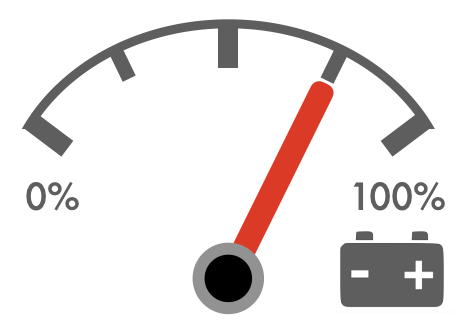 How long off the grid? – As discussed above, most popular deep-cycle batteries used for camping have a stored energy capacity of 120Ah (Amp Hours).
How long off the grid? – As discussed above, most popular deep-cycle batteries used for camping have a stored energy capacity of 120Ah (Amp Hours).
In reality, you can only depend on 80% of the label capacity for Lithium batteries (96Ah for a 120Ah battery), and 50% for AGM batteries (60Ah for a 120Ah battery).
Based on these numbers, the maths says that if you are using 30-40 Ah of stored electrical energy per day you will be able to run your 12V appliances for 1-3 days without recharging, depending on the type of battery (AGM or Lithium) and how much energy your fridge is consuming. In our experience, using a Kings 120Ah Lithium battery, and running only the fridge, we can last 5 days (or more) with no recharging.
Important: Only use a deep-cycle battery, not a vehicle starter battery.
 AGM v Lithium battery? – As noted above, Lithium is the best option if you are buying a new battery for a portable power supply.
AGM v Lithium battery? – As noted above, Lithium is the best option if you are buying a new battery for a portable power supply.
A 120Ah deep-cycle AGM battery has a ‘usable’ capacity of 50%, or 60Ah of storage capacity. AGM batteries are lead-acid batteries and are very (very) heavy. (Over 30kg for a 120Ah AGM battery)
A 120Ah deep-cycle Lithium battery has a ‘usable’ capacity of 80%, or 96Ah of storage capacity. Lithium batteries weigh in at under 15kg, and can be easily picked up and loaded in a car, or moved around a campsite. When Lithium batteries were over $1000, AGM batteries were the obvious choice. Now that Lithium batteries are under $400, they really are the best option.
Not only are Lithium batteries much lighter, they will keep your fridge running for longer periods, and will have a longer lifespan.

Repeatedly discharging an AGM battery to lower than 50% capacity, or a Lithium battery to lower than 20% capacity, will shorten the life of the battery. When stored between trips, keep a Lithium battery at around 60% capacity, and an AGM battery at 100% capacity.
*Note: There are still some cheaper 120Ah Lithium batteries available online that have dodgy construction, or aren’t really 120Ah. Check out Youtube for some tests of cheap Lithium batteries.
Which battery to buy? – In the notes above I have recommended the Kings 120Ah Lithium batteries as currently the best option for use in a portable camping power supply. These batteries are available from Adventure Kings stores for around $350. The Kings batteries are affordable and reliable.
Other options include batteries from iTechWorld and KickAss, though they are generally more expensive than the Kings batteries, with no real operational benefit other than peripheral additions such as bluetooth monitoring, etc.
Update: another low cost option – only new, no reviews yet – Dune 120 Ah Lithium battery (~$350)

All retailers have regular ‘specials’, so keep an eye on their websites, or sign up to their mailing lists. However the Kings batteries are regularly the cheapest, and while there are often caveats with cheap gear, Kings batteries appear to be reliable and good quality.
Affordable Lithium battery options to fit in your battery box….
-
-
-
- Kings 100 Ah Lithium Battery ($250 – on special)
- Kings 120Ah Lithium battery ($350 – on special)
- Dune 120 Ah Lithium Battery ($350 – on special)
- KickAss 120Ah Lithium battery ($500 – on special)
- iTechworld 120Ah Lithium battery ($750)
-
-
As always, check for regular marketing ‘specials’ ….. EoFY, Black Friday, Camping Shows, etc.
-
-
 See also: Kings Lithium Power Packs – suitable for day trips or overnight trips, and are very portable:
See also: Kings Lithium Power Packs – suitable for day trips or overnight trips, and are very portable:
-
-
-
- More detailed battery info: Deep-cycle Campervan & RV batteries >>>
-
Once you have sorted a battery, you will need something to put it in, as well as a means of connecting your fridge (and other devices) to the battery – enter the ‘powered’ Battery Box.
Note: Most suppliers offer a Battery and Battery Box ‘Combo’ deal, for less than the cost of purchasing each item separately. Often available as ‘specials’.
A powered Battery Box provides plug ‘n’ play connections to a 12V battery (AGM or Lithium), while keeping the battery secure in your vehicle. (Not to be confused with plain vanilla, unpowered plastic battery boxes which are designed only to house a battery, without providing any electrical connections.)
Powered Battery Boxes are pre-wired with Anderson plugs, 12V cig sockets, USB outlets, a voltmeter, inline fuses, and a circuit breaker. Some Battery Boxes are more affordable than others, and others have a wider range of plug sockets….
-
-
- Kings Battery Box ($60 – on special for $40) – good budget option, offering a full range of connection sockets – 2 x Anderson, 1 x Cig, 2 x USB, screw terminals, plus a voltmeter, circuit breaker and isolator switch.
-
KickAss Portable Battery Box ($300) – takes your Battery Box to power station territory, with a stack of additional sockets, including a 175A Anderson plug for connection to a high power inverter (Lithium battery required). iTechWorld have an identical product for a similar price.
- Kings Batblock25 ($400) – a more substantial housing for your battery, with a built-in DC-DC charger for hooking up to your vehicle alternator. Has all the usual cig/USB/Anderson/ sockets, plus a high power connection for an inverter.
-
iTechWorld GoFurther Battery Box ($600) – much the same as the KickAss Portable Battery Box, with the addition of a built-in DC-DC charger and a similar wide variety of ports, including a 175A Anderson socket. (KickAss have a similar box incorporating a DC-DC charger for $800). You only need this sort of thing if your vehicle is setup with a permanent connection to the vehicle alternator.
-
Kings and iTechWorld (and sometimes KickAss) occasionally offer special pricing for Battery Boxes bundled with a battery. Join their mailing lists to keep up to date with these special offers.
-
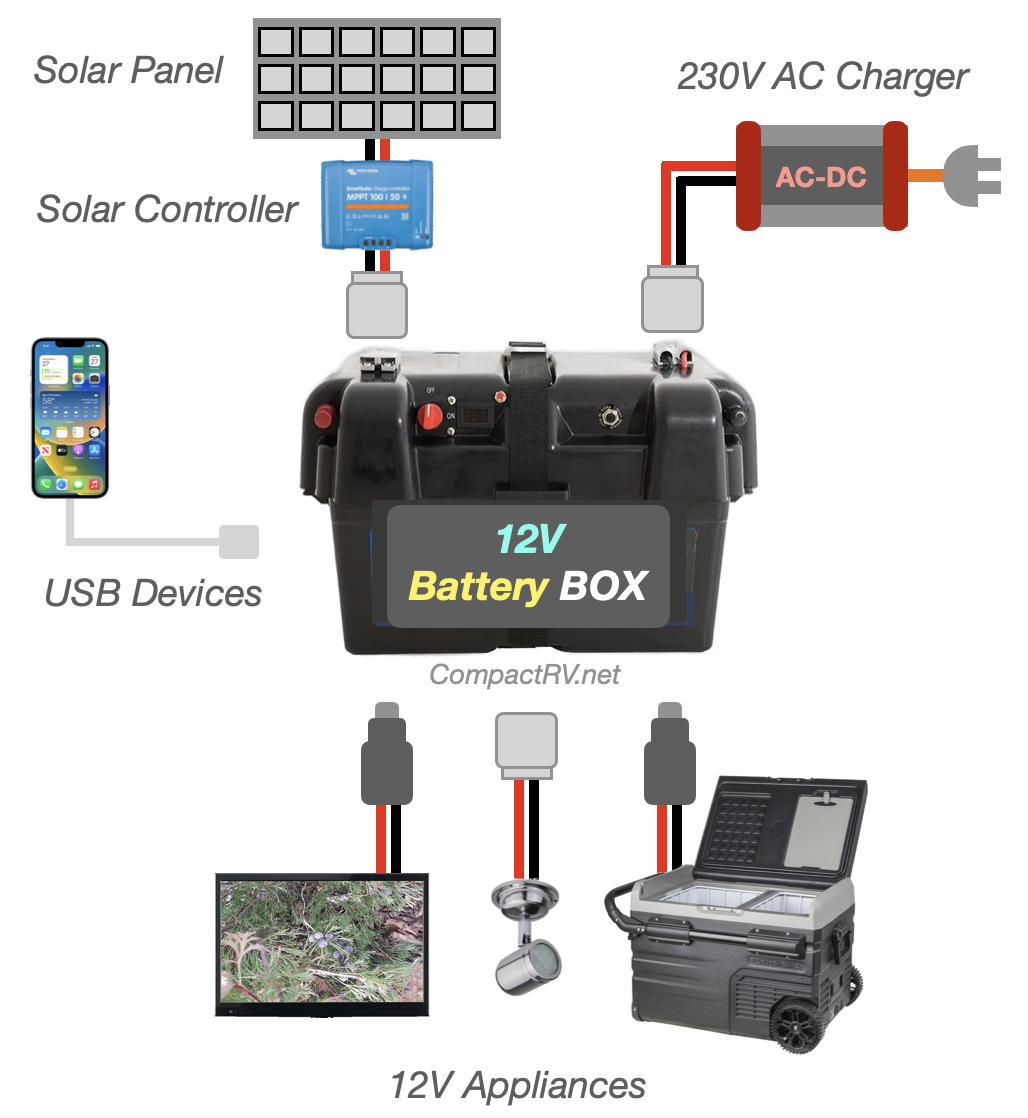
Regardless of which Battery Box you choose, the box must be strapped down in your vehicle for safe transportation – you don’t want 30kg of AGM battery (or 12kg of Lithium battery) floating around the car in the event of sudden braking, or in a collision!
See also: Add a Battery Monitor to your Battery Box (for Lithium Batteries) >>>
Need more outlets?
A typical mini power distribution box includes 6 x USB Ports, 3 x 12V Cig Sockets and 2 x Anderson-style input/outputs. (Note: Consider the total power draw of all connected devices – basic Battery Box outlets are limited to 30 Amps output.)
|
4. Battery Recharging
You can extend the run-time of your fridge considerably by recharging your battery.
Battery charging in a nutshell….Use a solar panel (and solar controller) to extend your battery life when you are off the grid. Use a 230V charger to recharge your battery at home, or when you have mains power available. Run your fridge from your car’s 12V Cig socket while driving to preserve battery capacity. |
|
You have three options for recharging a deep-cycle 12V battery:
-
-
- Solar panel;
- Mains supply;
- Vehicle alternator.
-
All three recharging options require a regulator / charger connected between the power source and the battery, to regulate and adjust the voltage and current feeding into the battery.
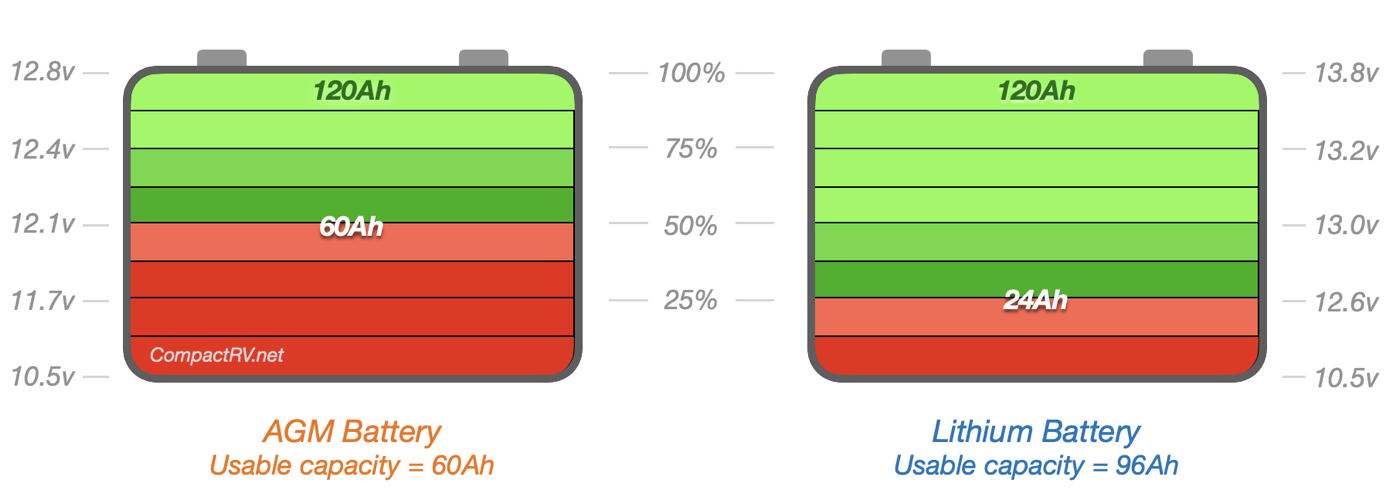
In the portable fridge and 12V power environment that we are discussing here, a solar panel is the go-to option for extending your battery’s life while camping.
For fully charging the battery before you leave on a trip (or when you return), and keeping it in good condition before your next trip, a multi-stage mains charger is an essential option.
Charging your battery from the vehicle alternator requires some permanent cabling and a not-so-cheap DC-DC charger, which is not necessarily appropriate for our portable setup for short trips. And keep in mind that your fridge can probably be run from the vehicle’s cig socket when travelling anyway.
Battery recharging – Solar Controllers & 230V Chargers
This energy generation reaches its peak in the middle of the day, if the surface of the solar panel is perpendicular to the angle of the sun in the sky. Voltage and current from a solar panel are regulated by a solar controller before being fed into your battery. Output from a solar panel is around 20V, but your battery will be damaged by input greater than around 14V. The solar controller gets this sorted. A good quality 200W solar panel may be producing 10 amps of current in the middle of a clear sunny day (returning 10Ah of energy to the battery each hour), but may only be generating 4 amps mid-morning and afternoon, and less than 1 amp either side of this. (A cheap 200W blanket may only be producing 6 amps in the middle of the day.) And that is if the sun is shining. Remember that your fridge will also be using a couple of battery amps per hour throughout the day (and night). A solar panel will return electrical energy to the battery, and extend the battery’s capacity to continue running a fridge and other 12V devices. But you are unlikely to fully recharge a 120Ah battery with a single portable solar panel while the fridge is running, and it may take several sunny days to recharge a battery without the fridge connected. Even then, the battery may not be fully charged, depending on the quality of your solar controller. Which is fine, while you are camping – just so long as there is enough charge in the battery to keep the fridge running.
The easy way to ensure a fully charged battery is to recharge your battery with a 230V AC multi-stage smart charger at home, to guarantee your battery is fully charged before your next excursion. A 230V AC charger will deliver a consistent charge rate, day or night. A small 12 amp multi-stage smart charger will (dependably) fully recharge a 120Ah battery in under 12 hours. A charger with a higher rate of charge will recharge a battery more quickly – check your battery specifications for the maximum recharge rate. |
Solar Charging
A solar panel is the most universal charging option, and can be used anywhere the sun is shining.
Unfortunately it can also be a relatively slow charging option, unless you have a good size solar panel (at least 200W), and can only generate electricity during daylight hours – if the sun is shining.
If you hook up a solar panel (and solar controller) that can deliver at least 6 amps (restoring 6 Ah stored battery energy per hour), you will be able to generate enough electricity to recharge your battery, greatly extending the run time of your fridge – in sunny weather.

Even though your solar panel might be capable of restoring battery energy at up to 10 Ah per hour (in the middle of the day), your fridge is consuming 1 – 2Ah – every hour, day and night. The net additional current input from the solar panel needs to be enough to not only cover for the fridge usage in the day time, but to also restore the energy used by the fridge the previous night, when no solar input was available.
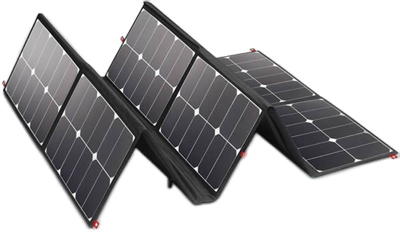 Solar panels – Options and costs vary depending on the size and quality of the panel and regulator you choose. Consider 150W a minimum sized panel to provide a reasonable output.
Solar panels – Options and costs vary depending on the size and quality of the panel and regulator you choose. Consider 150W a minimum sized panel to provide a reasonable output.
In full sunshine, in the middle of the day, a 150W glass panel will produce about 7 amps.
Solid solar panels with a glass surface are the most reliable and durable panels, but they are bulky to carry. Folding solar blankets have become popular over the last few years, and are rapidly improving. They fold down into a small package, making them easier to carry on a trip.
A solar panel produces electricity at around 20V, and requires a solar controller (or regulator) to connect the panel to the battery. The controller reduces the panel output to around 14V, to avoid damaging your battery. (Note: There is a wide range of solar controllers available. Spend the extra dollars to buy a good quality controller, to ensure your battery is not damaged by overcharging.)
Which solar panel to buy? For compact storage look at foldable solar blankets. If you have the storage space in your vehicle, a folding hard-frame panel will probably generate more reliable current. It has been our experience that the cheaper panels / blankets produce less current than the more expensive models, especially as they age, and suffer from the travel environment.
Look for at least 150W output, but 200W will greatly extend your battery / fridge run time….
Don’t forget a solar controller: Remember, you MUST have a solar controller fitted between your solar panel and the battery to regulate the current and voltage being fed into the battery. MPPT controllers are the best option. A good quality MPPT solar controller, with a digital volts/amps display screen, will cost around $100-$150. (Make sure it is rated for Lithium batteries.)
More info: Solar charging | Solar charging – the Nitty Gritty
How long will it take to recharge a 100 Ah battery?
If you are using a 10 amp mains charger to recharge a 100 Ah AGM battery, it will take up to 11 hours to recharge the battery to 100% charge capacity (with no appliances connected). Hook the battery up to the charger at 8:00pm at night and it should be fully charged by 8:00 am in the morning. A 20 amp charger will charge the battery in around 6 hours. If you are charging your 100Ah battery with only a portable solar panel, averaging 3 amps output over a sunny day, it will take around 40 hours (and these are sunshine hours) to deliver enough current to recharge a 50% discharged AGM battery. And that is without any appliances running concurrently to consume current. |
Mains Charging
Chargers that use 230V mains current provide a more efficient and reliable charging option than solar.
Good 230V chargers (smart chargers) charge the battery in multiple stages, tailoring voltage and current to suit the charge state of the battery.
Charging from 230V is a good option for fully charging your battery before a trip, and keeping your battery in good condition between trips.
 230V AC Battery Charger – Before leaving for a trip you should ensure that your battery is fully charged.
230V AC Battery Charger – Before leaving for a trip you should ensure that your battery is fully charged.
Yes, it is possible to pre-charge your battery with a solar panel, but that is not always an option if the weather is crook before you leave, or you don’t have a large sunny space to leave it out all day (or for a couple of days).
Solar charging is also much slower than charging from a mains outlet, and may not fully charge your battery.
The only 230V charger to buy is a ‘smart’ charger. These chargers are microprocessor controlled – they detect the battery’s state of charge and tailor their output voltage and current (in 5 or more stages) to suit the battery and its’ progress on the charging scale.

A 230V smart charger will charge your battery overnight, keep it in good condition when it is not being used, and guarantee that you start your trip with a fully charged battery. These chargers can be left connected to your (AGM) battery 24/7 and will keep your battery in top condition, ready for the next trip. (Make sure that your Battery Box’s isolation switch is turned on when charging.)
The ideal rate of charging for an AGM battery is between 10% and 20% of its capacity – for a 100Ah battery a charger between 10A and 20A output. 10A chargers are cheaper than 20A chargers, and slower charging is not necessarily a bad thing for battery health.
If charging a Lithium battery, make sure your charger has a Lithium profile. A Lithium battery can recharge more quickly than an AGM battery, but shouldn’t be connected permanently to the charger – it doesn’t need trickle charging like an AGM battery.
If storing your Lithium battery between trips, it is best for long term battery health to leave it at around 60%-70% charge.
Which mains charger to buy? There are plenty of 230V AC chargers available at camping and auto supply stores, ranging in price from $80 to $500. KickAss chargers are available online at a reasonable price. If you go hunting around, make sure the charger has a Lithium mode.
-
-
-
KickAsss: 22 amp 230V smart AC charger ($179)
- Dune: 12A 230V AC Charger ($90)
-
-
 Another plus for the KickAss chargers is that they have an Anderson plug on the output cable, providing a direct connection to the plugs on your battery box, rather than using the more common (and less reliable) alligator clips.
Another plus for the KickAss chargers is that they have an Anderson plug on the output cable, providing a direct connection to the plugs on your battery box, rather than using the more common (and less reliable) alligator clips.
The Anderson Connection
Most battery boxes include two (or more) 50A Anderson connection sockets. A wide variety of Anderson adaptors are available, to hook up with other 12V connectors. We have found these adaptors particularly useful for hooking up an inline power meter (see above) for measuring appliance power consumption and solar panel input, etc. Available online, and at retailers such as Jaycar. |
12V DC-DC Battery charger
 Charging your camping battery from your vehicle alternator when the engine is running requires a DC-DC charger and the installation of some permanent cabling from under the bonnet to the rear of the vehicle – a bit beyond the scope of this discussion about an easy ‘weekender’ setup with a portable fridge and temporary 12V power supply.
Charging your camping battery from your vehicle alternator when the engine is running requires a DC-DC charger and the installation of some permanent cabling from under the bonnet to the rear of the vehicle – a bit beyond the scope of this discussion about an easy ‘weekender’ setup with a portable fridge and temporary 12V power supply.
If you want to go down this more permanent path, some more expensive Battery Boxes are available with a built-in DC-DC charger – which will also require a cabling kit to connect to the vehicle alternator / battery…
-
-
- iTechWorld: Alternator cabling kit ($80)
- KickAss: Alternator cabling kit ($80)
-
Or buy a charger and wiring kit to add vehicle charging to a basic Battery Box….
-
-
- Kings: 25A DC-DC charger & alternator cabling kit ($250)
-
Brass Monkey fridges with an (optional) removable battery have a built-in AC-DC charger, for charging the internal battery from mains power, and a built-in DC-DC charger to charge the battery via a cig socket while travelling in the vehicle.
Most fridges are supplied with a 12V adaptor (cig lighter socket) to power the fridge while travelling.
-
-
- More info on DC-DC Chargers: Recharging Campervan Batteries
- Get it right: DC-DC charger cabling to alternator
-
Thinking of an Inverter?
An inverter is used to run 230V AC appliances from your 12V battery – but they suck a lot of amps. A 100 Ah Lithium battery can supply continuous current at up to 100 amps, resulting in a power draw of around 1000 Watts. But we need to keep in mind that the internal wiring in a Battery Box can carry a maximum current of around 40 amps – so the wiring in most base level battery boxes are protected by a 30A circuit breaker. If you want to draw more than 30A you will need to look beyond a basic Battery Box, to something like a Kings BatBlock, which can supply up to 100A..
Low power inverter options: Remember it is not the inverter that is drawing current from your battery but the appliances that you connect to the inverter. Using one of these inverters connected to a battery box will be OK for charging a laptop, camera batteries, drone batteries, or an e-Bike battery, so long as you have enough solar input to recharge your deep-cycle battery. Check the power draw (in Watts) of any 230V AC appliances you might be thinking about plugging in to an inverter. A laptop charger draws around 50W – 100W. (Also remember that a 100W appliance is depleting up to 10 Ah per hour from your 120Ah Lithium battery, which has a usable capacity of around 96 Ah.) Let’s not forget…
More info: Installing an Inverter in our Campervan >>> |
But wait – there’s more….
The All-in-One Power Station Option
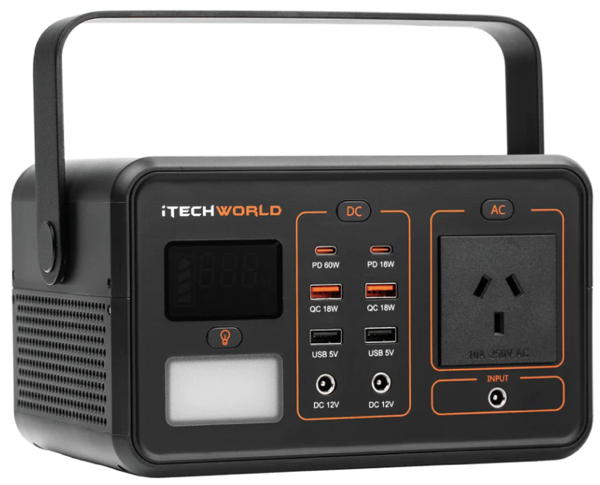 Rather than building a 12V power supply using a powered Battery Box as discussed above, you could take the one-stop-shop shortcut with a Portable Power Station (powered by a Lithium battery) for an instant power supply, with built-in charging and inverter facilities, all in one neat, easy to carry package…
Rather than building a 12V power supply using a powered Battery Box as discussed above, you could take the one-stop-shop shortcut with a Portable Power Station (powered by a Lithium battery) for an instant power supply, with built-in charging and inverter facilities, all in one neat, easy to carry package…
-
-
- iTechworld: 800P – 40Ah ($900)
- iTechWorld: PS1300 – 100Ah ($1300)
- KickAss: DC500 – 40Ah ($450)
- KickAss: KickCharge 1200 – 80Ah ($950)
-
Most power stations include a built-in solar controller for easy connection of a solar panel for off-grid recharging, as well as built-in regulators for 12V DC and 230V AC charging, along with a 230V AC inverter for directly connecting mains powered appliances. (You will need to choose a larger model to run power hungry appliances such as a coffee machine or sandwich press,. etc.)
A 50Ah Lithium battery will go close to providing a similar fridge run-time to that provided by a 100Ah AGM battery. Well, 90% maybe – and 1/3 the weight.
Certainly worth doing the sums before investing in a Lithium battery and powered Battery Box, and all the charging gear and extra connectors, etc.
Hot water? Shower?
|
<<< Getting started with a Portable Fridge & 12V Power
Batteries | Consumption | Battery Recharging | Solar Charging | How Long Without Sun? | Alternate Charging Options | Solar Regulators | The Bottom Line
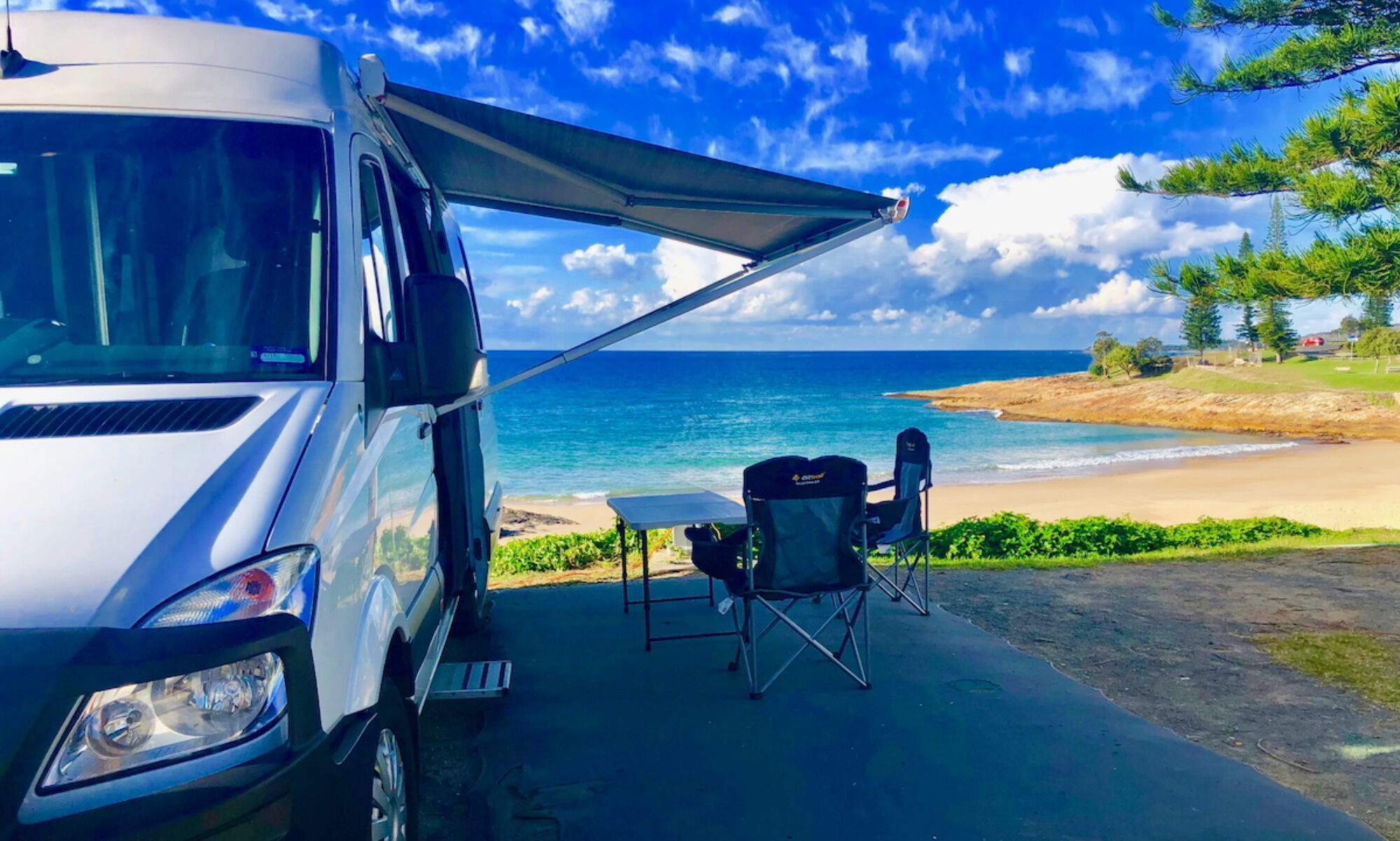

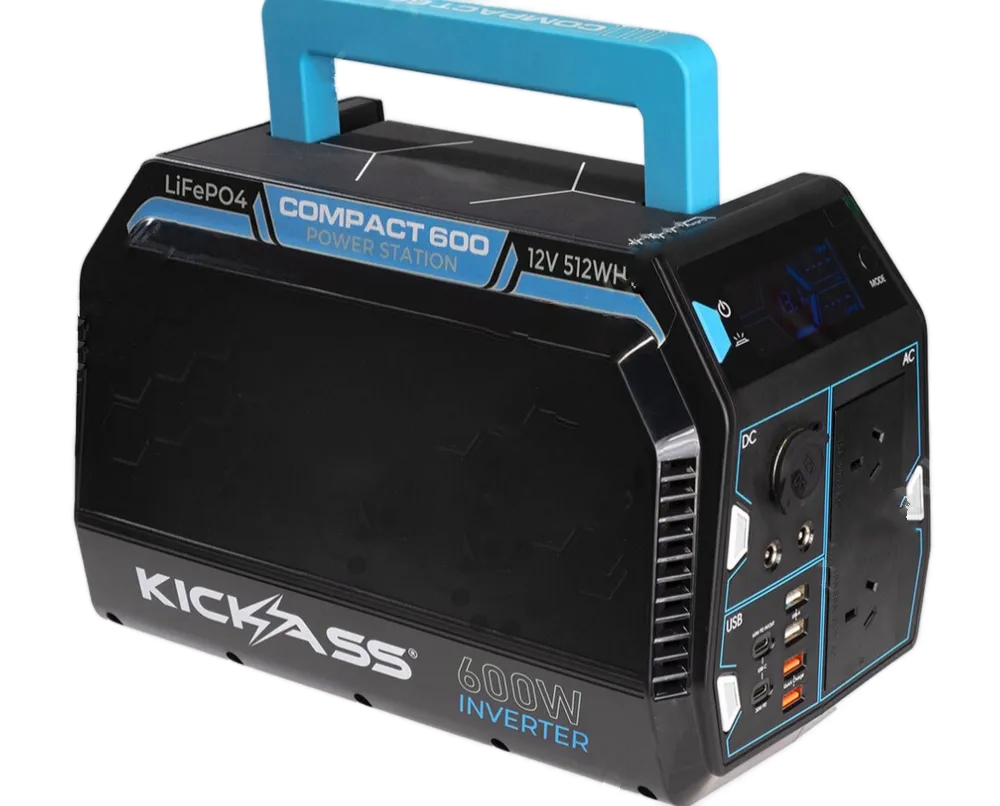 Many of the portable 12V power options listed below are built around a powered Battery Box, fitted with a Lithium battery.
Many of the portable 12V power options listed below are built around a powered Battery Box, fitted with a Lithium battery. 
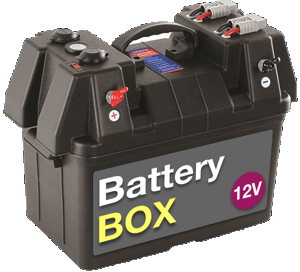





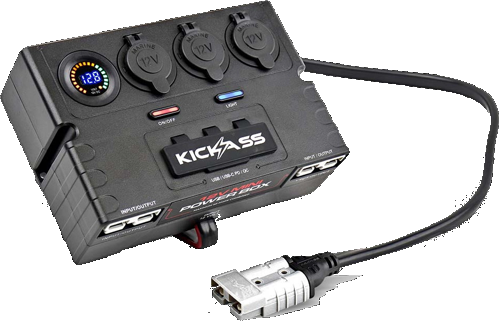 Use a mini Power Box extender to distribute power from your Battery Box to multiple additional outlets, to power up to 11 different devices at once.
Use a mini Power Box extender to distribute power from your Battery Box to multiple additional outlets, to power up to 11 different devices at once. A solar panel generates electrical current when struck by photons from the sun.
A solar panel generates electrical current when struck by photons from the sun. But what about getting the battery fully charged before you head off on a trip?
But what about getting the battery fully charged before you head off on a trip? A rough rule of thumb to estimate AGM battery charge time is to divide the amp hour rating of the battery by the charger’s amps rating and then add 10%.
A rough rule of thumb to estimate AGM battery charge time is to divide the amp hour rating of the battery by the charger’s amps rating and then add 10%. Anderson plugs are reliable click-together 12V connection plugs.
Anderson plugs are reliable click-together 12V connection plugs. An inverter connected to your Battery Box is a possibility – if your needs aren’t too great!
An inverter connected to your Battery Box is a possibility – if your needs aren’t too great!

 The bottom line is that if you are considering using an inverter with a Lithium battery for running higher power appliances in this kind of environment, you will need a more expensive Battery Box with heavy duty wiring and high-power connections, such as those available from
The bottom line is that if you are considering using an inverter with a Lithium battery for running higher power appliances in this kind of environment, you will need a more expensive Battery Box with heavy duty wiring and high-power connections, such as those available from